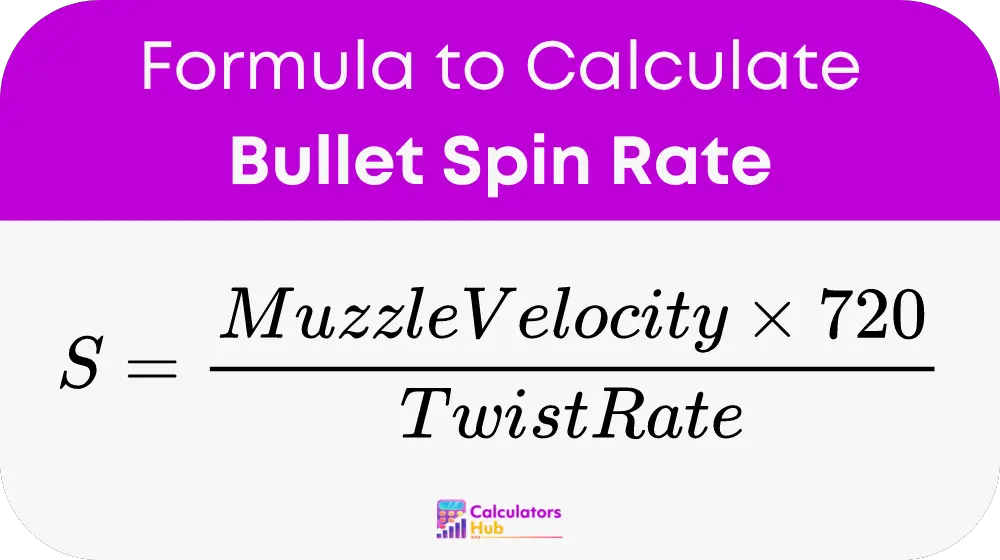The Bullet Spin Rate Calculator helps shooters, reloaders, and ballistics enthusiasts calculate the rotational speed of a bullet as it exits the barrel of a firearm. The spin rate, measured in revolutions per minute (RPM), plays a crucial role in stabilizing the bullet during flight, impacting its accuracy, stability, and trajectory. Bullets need to spin at the right speed to maintain a stable flight path, and this spin is imparted by the rifling grooves inside the barrel.
Rifling consists of helical grooves inside the barrel that engage the bullet and cause it to spin as it travels toward the target. The Bullet Spin Rate Calculator uses muzzle velocity and twist rate to calculate the bullet’s spin rate, providing valuable insights into how well a bullet will perform in various shooting conditions.
Formula for Bullet Spin Rate Calculation
The formula to calculate the bullet spin rate is:

Where:
- S is the spin rate, measured in revolutions per minute (RPM).
- Muzzle Velocity (V) is the speed of the bullet as it exits the barrel, usually measured in feet per second (ft/s) or meters per second (m/s).
- Twist Rate (T) is the barrel's rifling twist rate, usually measured in inches per turn. A common notation for this is 1:12, meaning one full turn in 12 inches.
The factor 720 converts the muzzle velocity and twist rate into revolutions per minute. It accounts for the unit conversions (from inches to feet) and the fact that there are 60 seconds in a minute.
Breakdown of the Formula
- Muzzle Velocity (V): This refers to the speed at which the bullet exits the barrel. Muzzle velocity is usually provided by ammunition manufacturers and can vary depending on the firearm, bullet type, and powder charge.
- Twist Rate (T): The twist rate describes how quickly the rifling in the barrel causes the bullet to rotate. For example, a twist rate of 1:12 means the bullet makes one full revolution for every 12 inches it travels through the barrel. Faster twist rates (lower numbers, such as 1:8) cause bullets to spin more rapidly.
For example, if a bullet has a muzzle velocity of 3,000 feet per second and the barrel twist rate is 1:10 (one turn in 10 inches), the bullet’s spin rate is:
Spin Rate (S) = (3,000 ft/s * 720) / 10 = 216,000 RPM
This means the bullet is spinning at 216,000 revolutions per minute as it leaves the barrel.
Quick Reference Table
Here’s a quick reference table that shows different combinations of muzzle velocities and twist rates, along with the resulting spin rates:
| Muzzle Velocity (ft/s) | Twist Rate (inches/turn) | Spin Rate (RPM) |
|---|---|---|
| 2,500 | 1:12 | 150,000 |
| 2,800 | 1:10 | 201,600 |
| 3,000 | 1:9 | 240,000 |
| 3,200 | 1:8 | 288,000 |
| 2,700 | 1:14 | 138,857 |
This table helps shooters quickly estimate the spin rate of bullets based on various muzzle velocities and barrel twist rates.
Example of Bullet Spin Rate Calculation
Let’s go through a practical example of using the Bullet Spin Rate Calculator.
Suppose you are shooting a .223 Remington bullet with a muzzle velocity of 3,100 feet per second. Your rifle has a twist rate of 1:9 (one full turn in 9 inches). To calculate the bullet spin rate:
Spin Rate (S) = (3,100 ft/s * 720) / 9
Spin Rate = 223,200 / 9 = 24,800 RPM
This means that as the bullet exits the barrel, it spins at approximately 24,800 revolutions per minute. The spin rate is important because it ensures the bullet remains stable in flight, which directly affects accuracy and distance.
Most Common FAQs
The bullet spin rate is important because it stabilizes the bullet in flight, ensuring it maintains a straight trajectory. Proper spin helps prevent wobbling or tumbling, which can cause bullets to deviate from their intended path, reducing accuracy. Too little spin may result in an unstable bullet, while too much spin can cause over-stabilization, affecting long-range shooting performance.
The twist rate directly affects how fast the bullet spins as it travels through the barrel. A faster twist rate (e.g., 1:8) causes the bullet to spin more quickly, which is beneficial for stabilizing heavier, longer bullets. A slower twist rate (e.g., 1:14) is more suitable for lighter bullets. Selecting the correct twist rate ensures that the bullet remains stable throughout its trajectory.
Yes, a bullet can be overspun if the twist rate is too fast for its size or weight. Overstabilization can cause the bullet to maintain an exaggerated nose-up or nose-down orientation throughout its flight, which may reduce accuracy, particularly at long ranges. It’s important to match the twist rate with the bullet weight and type to ensure optimal stability.